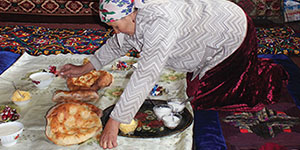
A great variety of Central Asian domestic textiles incorporated kurak (patchwork) in their design. One of the largest of these was the tush ki'iz, a large-scale patchwork and/or embroidered panel, which was a focal point of the Kyrgyz trellis tent, or boz üy (known in the West as a yurt). It traditionally hung in a special area called the tör (the back wall of the tent opposite the door), creating a striking and beautiful backdrop for the jük—the home's decoratively folded pile of bedding and quilts. It was an important dowry article, made by the bride under the tutelage of her mother or a revered ancestor. The characteristic Kyrgyz form is a horizontal rectangle, eight to twelve feet wide by six to nine feet high, with a patchwork or embroidered panel along the top and both sides.
Additional kurak items included mirror bags (oina khalta) and hairbrush bags (shona khalta), which might also hold soap, needles, thread, thimbles, or other sundries. After marriage, the bride hung them in a prominent location to ward off evil spirits. Bags of different sizes for teapots, as well as potholders and patchwork shelves that served as storage units, hung from the lattice framework of the nomadic tent. For baking bread in the deep traditional clay oven (tamdyr), the mother of a bride made a round, padded patchwork pad (raffida) to hold the dough and the accompanying glove (ostincha) that covered the upper arm when reaching into the fire. The young bride used these to make the first meal for her husband and relatives who, in turn, offered wishes for many children. For weddings and other ceremonies across Central Asia, kurak tablecloths (dastarkhan) made of brightly colored cotton were spread on the floor for meals. Eating a meal from a dastarkhan made of kurak was said to be pleasing to God and the longer you ate from it, the more your sins would be forgiven. Thus, such tablecloths would be worn out quickly.